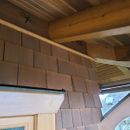ccPSF Inside Wall with 1″ of XPS on th Exterior
Hi
This will be one of many questions I’ll have regarding our house that is in Marine Zone 4. and approx. 5 miles from the Building Science Coquitlam Test Hut.
We are in the process of adding a 2nd floor to a 100 year old (2×4 wood construction) house.
The wall details (that are complete, see picture) from inside to out are:
2×6″ 16″ o.c
1/2″ plywood
Tyvek Homewrap
1/8″ x 1″ Vinyl strips – to allow for drying
1″ XPS
3/4″ Rain Screen Air Gap
Cedar Shingles
The wall are (mostly) protected from exterior rainfall (but not condensation) by a 48″ open rafter overhang.
I’ve been told the best way to finish the inside of the wall is ccPSF with a liquid vapor (required by code) barrier. It is possible that being a 100yo an argument can be made against the vapor barrier.
After reading articles and comments (Thank You Everyone!) on GBA I’m wondering if mineral wool with a vapor retarder is a better option?
Thank You
John
GBA Detail Library
A collection of one thousand construction details organized by climate and house part










Replies
A vapor retarder is usually a safer choice than a vapor barrier on the interior when such a thing is required by code.
Don't waste spray foam in a wall. While it's true spray foam gives a high R per inch number, the thermal bridging of the studs in a wall negate much of that advantage. Closed cell spray foam is especially bad here because it won't be filled to the full depth of the studs -- you'll have an air gap of around 1/2 to 1 inch on the interior side, which is around R3-R6 worth of performance reduction compared to what a full stud depth worth of spray foam would be. I would use mineral wool batts in the wall myself, along with a smart vapor retarder (Membrain, Intello, etc.) on the interior.
I wouldn't use vinyl strips "for drying" here. I'd either allow for drying to the interior side only (which would be the case with mineral wool and a vapor retarder, for example), and I'd put the rigid foam directly against the sheathing. If you want more drying potential for the sheathing, use EPS instead of XPS -- EPS is more vapor open.
Rain screens help a LOT with exterior drying, so you're good in your final exterior layers.
Bill
Bill,
Unfortunately the BC code requires an interior vapour barrier.
Hi Bill
Thank You for the response
The 1/8" x 1 vinyl has been installed. This was done because the building inspector (who has now moved on) required a vapor barrier on the inside.
It vinyl will reduce the effectiveness of the 1" XPS but I would guess it's similar to using mineral wool.
Thank You
John
John,
Are you removing the cladding on the first floor, or do you hope to do all the work from the inside?
Hi Malcom
Cladding and Shiplap will be removed. The engineer wants the 2x4 balloon framing reinforced and sheer walls.
It's hit and miss regarding air/water barriers. Our inspector said we have to have a vapor barrier. What he didn't tell us is we don't need a vapor barrier or even a vapor retarder if an Envelope Engineer gives the OK.
Thanks
John
John,
If you build both the old and new walls with the assembly you have suggested (rain-screen and exterior foam), with batt insulation in the stud bays, an interior vapour-barrier, and drywall, you are reproducing (minus the rain-screen) what is now the standard wall assembly in Ontario. From all accounts it performs very well.
I think that's a code requirement for most, it not all, of Canada, correct? My brother in law is a builder outside of Toronto, and I remember when I first saw some of his projects I was surprised with the poly detailing EVERYWHERE. I didn't realize the OP was in Canada.
Have you ever been able to use a smart vapor retarder instead of the poly vapor barrier? Have any inspectors been ok with that?
Bill
Bill,
It seems that with small amounts of exterior foam in the Canadian climate, poly vapour-barriers - as opposed to a vapour-retarder or variable-perm membrane - help improve the resiliency of the wall - or certainly do no harm. I think it was Jon who linked to a BSC article on the topic.